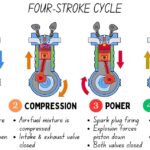The automotive industry has seen a significant shift towards the extensive use of plastic components. While heralded for their lightweight nature and cost-effectiveness, the increasing prevalence of plastic car parts raises concerns about durability and longevity, particularly when considering the role of Plastic Car Parts Manufacturers in this evolving landscape. It’s often observed that these parts, seemingly by design, tend to falter just outside the warranty period, leading to questions about the intended lifespan and quality. This is especially true for small, yet crucial, components like door latch assemblies, interior vent controls, door handles, and various panel latches and covers – areas subjected to frequent mechanical and thermal stress.
Personal experiences further highlight these issues. For instance, in regions with extreme climates, certain car brands have notoriously suffered from plastic degradation. Door handles turning into a sticky mess and hood gaskets crumbling under heat are not uncommon occurrences. These failures, especially in vehicles supposedly engineered for such conditions, underscore the limitations of certain plastics when exposed to environmental stressors. Interestingly, other brands, perhaps prioritizing different material choices, seem to fare much better under similar conditions, suggesting that material selection and design play a pivotal role.
Indeed, plastics are versatile materials and, when meticulously chosen and correctly engineered, can rival or even surpass metal counterparts. However, the reality often falls short of this ideal due to shortcomings in design, inadequate specifications, or subpar manufacturing processes employed by some plastic car parts manufacturers. The long-standing argument about weight reduction and improved fuel efficiency, while valid to a degree, often overshadows the more critical discussion about the suitability of plastic in high-stress applications.
The weight savings achieved by switching to plastic in less critical areas are often marginal compared to the significant decrease in overall vehicle reliability, increased long-term ownership costs, and potential compromises in driver safety. For components enduring substantial mechanical stress, a return to more robust materials like metal might be a necessary step to ensure vehicle longevity and customer satisfaction. As someone with a background in aerospace engineering and decades of international experience, the trend of replacing metal assemblies with plastic, seemingly at the expense of the consumer, is deeply concerning. This situation arguably warrants a closer look at industry practices and a push for greater accountability from plastic car parts manufacturers to prioritize durability and reliability over short-term cost savings.
Alt text for potential image (if an image of a broken plastic car door handle was included in the original article – none provided in this case):
Broken plastic car door handle illustrating common failure in high-stress plastic car parts from certain manufacturers.
